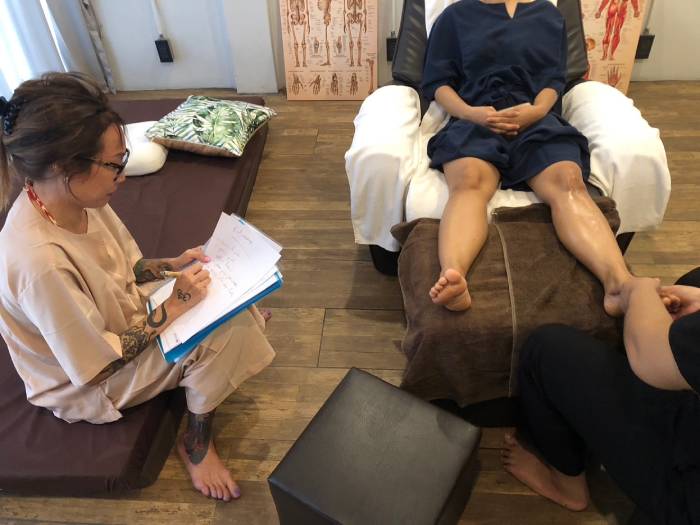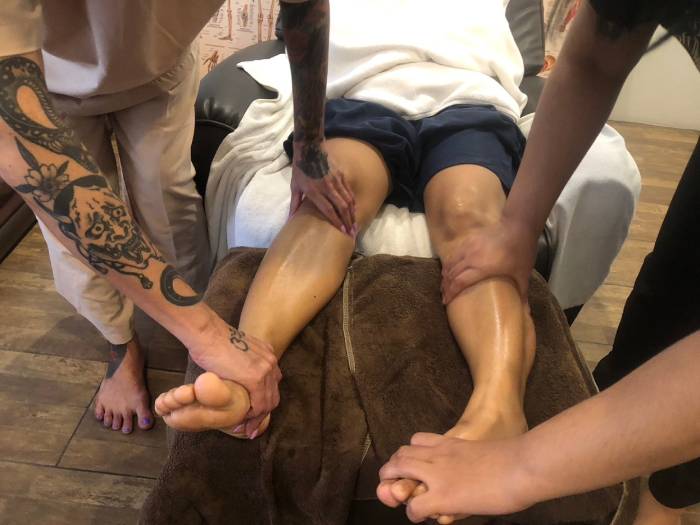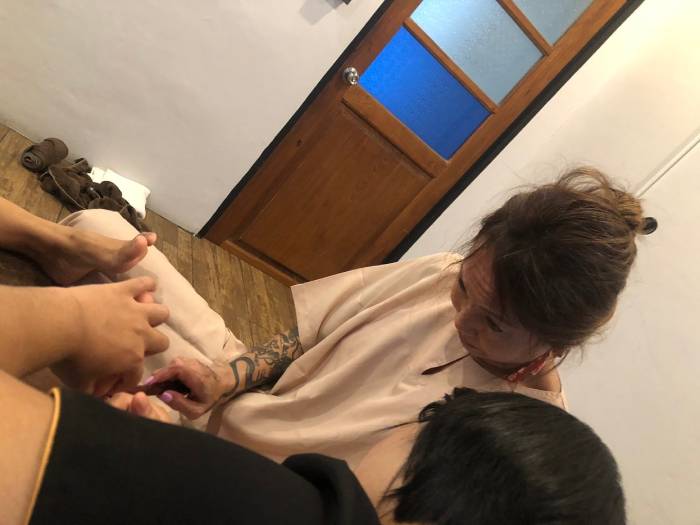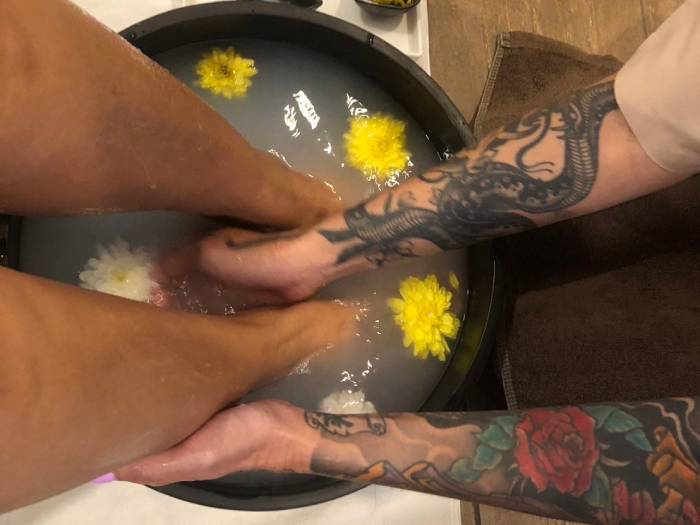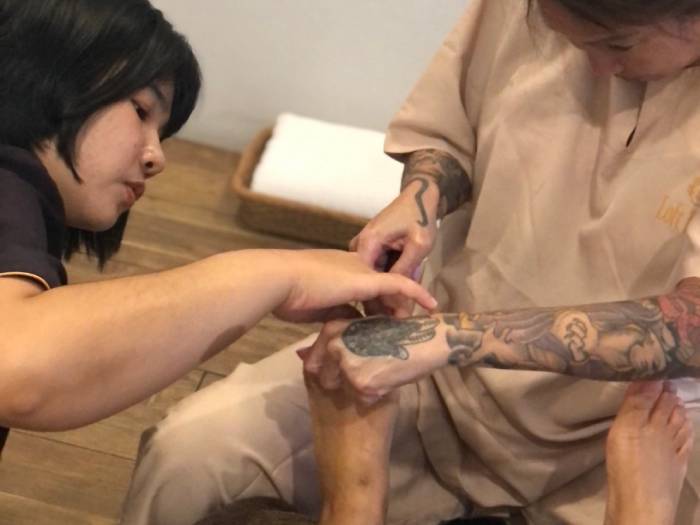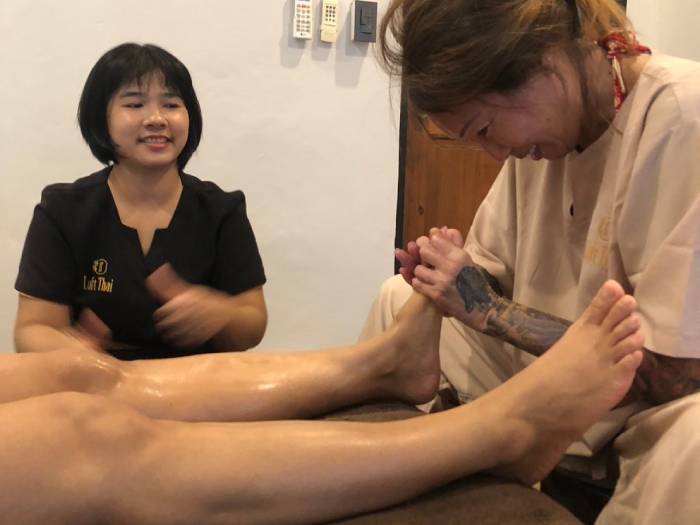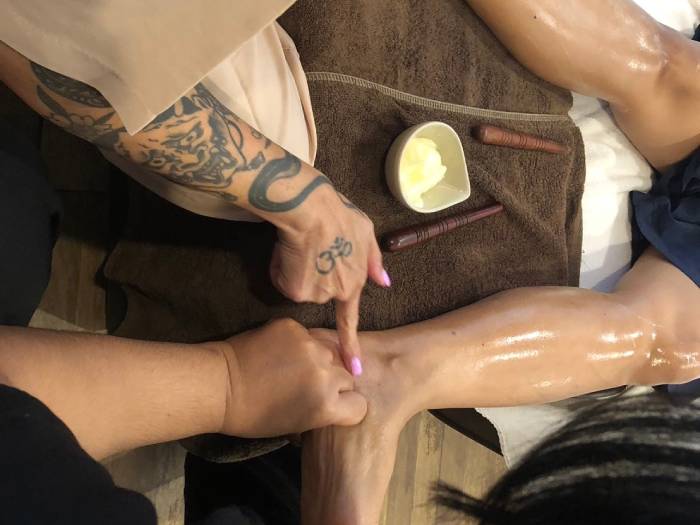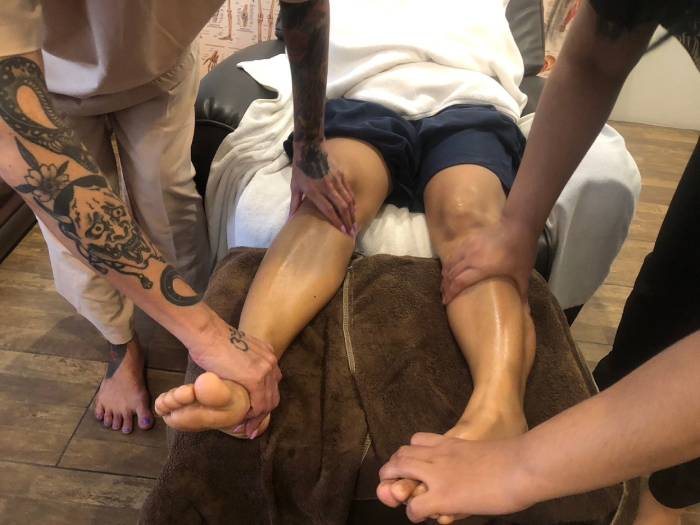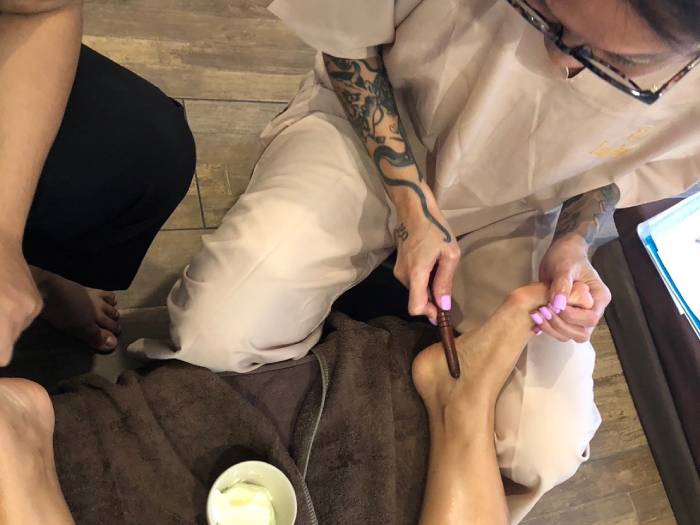Healing the Body Through the Feet
The Foot Massage Course offered by our massage school in Bangkok is a comprehensive and immersive program designed to teach students the art and science of traditional Thai foot massage. Whether you are new to bodywork or a practicing therapist seeking to expand your services, this course delivers a perfect balance of technique, theory, cultural insight, and therapeutic depth. More than just a pampering experience, Thai foot massage is a profound healing art rooted in ancient medicine, combining rhythmic pressure, reflexology principles, and skilled touch to stimulate energy flow throughout the entire body.
This course will guide students through every aspect of traditional Thai foot massage, from foundational theory to advanced application. It also includes the use of traditional Thai wooden tools, foot reflex charts, massage balms, and step-by-step sequences designed for both relaxation and therapeutic benefit. Upon completion, students will be able to confidently offer full-length foot massage sessions for a variety of clients, using techniques that are both deeply relaxing and health-enhancing.
Studying in the heart of Bangkok’s Sukhumvit district, students will not only receive professional-level instruction but also gain a cultural and spiritual understanding of Thai wellness philosophy. This course is ideal for anyone passionate about holistic health, spa therapy, or natural healing practices.
Enhancing Foot Massage with Additional Therapies
To provide a well-rounded learning experience, we introduce complementary wellness practices that elevate foot massage treatments. These include:
- Aroma Oil Massage: Learn how to integrate aromatic essential oils into foot massage sessions to enhance relaxation and create a deeper sensory experience.
- Thai Warrior Techniques: Incorporate advanced pressure techniques inspired by ancient Thai warrior traditions to provide deep muscle relief and improved circulation.
- Body Scrub & Wrap: Discover how exfoliation and herbal wraps can prepare the feet for massage, improving skin texture and overall foot health.
- Facial Treatment: Understand the connection between facial reflex zones and foot reflexology to offer holistic balance in spa and wellness settings.
Why Bangkok and Why Sukhumvit?
Bangkok is widely regarded as the epicenter of Thai traditional medicine and massage. Every year, thousands of people from across the world come to this vibrant city to learn the healing techniques passed down through generations. Among the sprawling metropolis, Bangkok maintains its ancient roots, particularly in the realm of wellness. Temples still offer healing rituals, and small massage shops thrive alongside luxury spas. This cultural richness makes Bangkok the perfect place to study foot massage in an environment where tradition and modern application co-exist seamlessly.
Located in the Sukhumvit district, our massage school is easily accessible and surrounded by a blend of old-world charm and contemporary lifestyle. Sukhumvit is home to boutique spas, authentic Thai eateries, international communities, artisan markets, and wellness cafés. Just outside the classroom, you’ll find inspiration and practice reflected in daily life—whether it’s a traditional healer preparing herbal balms or a therapist practicing foot massage in a local salon. With such a diverse and stimulating backdrop, students can immerse themselves fully in Thai wellness culture while enjoying the comfort and convenience of this central Bangkok neighborhood.
The Story and Cultural Roots of Thai Foot Massage
Thai foot massage is a healing tradition with deep roots in both Thai and Chinese medicine. It is based on the belief that the feet are a mirror of the body, containing pressure points and reflex zones that correspond to internal organs, glands, and energy pathways. In ancient times, Buddhist monks used foot massage as a tool for healing and meditation. Over time, the technique evolved into a structured practice, widely used in Thai households, temples, and traditional clinics to maintain health, reduce stress, and prevent illness.
Unlike Western reflexology, which tends to focus strictly on diagnostic and pressure-point theory, Thai foot massage is both therapeutic and deeply nurturing. It incorporates not only reflexology zones but also Sen Sib (Thai energy lines), acupressure, and rhythmic massage techniques to promote balance across the entire body.
The treatment typically starts with a gentle foot cleanse, followed by warm-up strokes, thumb-walking, knuckle rolling, and the use of a small wooden stick tool to stimulate specific pressure points. The entire session can include the feet, ankles, lower legs, and even the knees, depending on the client’s needs. It is both a science and an art—a language spoken through hands and tools, with deep awareness and sensitivity.
Understanding the Difference: Foot Massage vs. Reflexology
While the terms are often used interchangeably, foot massage and reflexology are not exactly the same. Reflexology is a specific therapeutic technique that targets precise pressure points on the foot believed to correspond with specific organs and systems in the body. Its goal is to stimulate internal healing and restore homeostasis, often without focusing on muscle relaxation or overall tactile flow.
Thai foot massage, by contrast, blends reflexology with traditional Thai massage principles, incorporating full lower-leg treatment, energy balancing, and flowing massage strokes. It includes both functional and relaxing aspects, aiming to restore both physical and energetic balance. In this course, students learn to integrate both approaches—delivering treatments that offer not only targeted health benefits but also holistic, full-body relaxation and stress relief.
Course Preparation and Environment
Students enrolling in the Foot Massage Course are advised to arrive with a willingness to learn, a gentle mindset, and an appreciation for touch-based therapy. No prior experience is required, although previous massage or wellness training can enhance the learning experience.
Our training environment in Sukhumvit is quiet, well-lit, and fully equipped with Thai mats, towels, herbal massage balms, foot charts, and a complete set of traditional wooden tools used in Thai foot massage. These include the Thai foot massage stick, which is a small, rounded wooden rod used to apply precise pressure on reflex points, and wooden rollers or balls used for warming up the foot.
Students are encouraged to wear loose-fitting, comfortable clothing as they will be both giving and receiving massage during class. Footwear is removed in the classroom to foster mindfulness and maintain the cleanliness and sanctity of the space. Herbal tea and drinking water are provided daily to support hydration and relaxation.
Training Structure: Step-by-Step Mastery of Thai Foot Massage
The hands-on training is the core of the course. Students begin by learning the anatomy of the foot and lower leg, including the major reflex zones, energy pathways, and muscular structures. A foundational understanding of how touch affects the nervous and circulatory systems is also introduced, enabling students to work safely and effectively.
The course then progresses through practical sequences that are broken down into manageable steps. The instructor demonstrates each movement, and students immediately practice with supervision and feedback.
Training begins with client preparation and foot cleansing rituals, which not only set the tone for the treatment but also respect Thai tradition and hygiene. A warm towel or herbal foot soak is often used to cleanse and soften the skin, while also promoting immediate relaxation.
Once the feet are clean, the practitioner begins the warm-up phase, using gentle effleurage and gliding strokes with both hands and forearms. This prepares the tissues for deeper work and begins to awaken the sensory receptors in the feet and ankles.
The next step involves reflex zone activation using thumbs, fingers, and knuckles. Each reflex point is stimulated with pressure and rhythm. For example, pressure on the ball of the foot is believed to support lung and heart function, while pressure on the heel supports the sciatic nerve and lower back.
Students then learn to use the Thai wooden stick tool, a signature component of this technique. The instructor explains how to position the stick, apply safe and effective pressure, and use it to stimulate deeper points without fatigue. The stick allows for greater accuracy and can be used to create varied intensity depending on the client’s comfort.
The treatment continues to the ankles and lower legs, where circular massage, tapping, kneading, and joint mobilization are introduced. These strokes enhance blood flow, reduce swelling, and support venous return—making them ideal for clients who stand for long periods or suffer from poor circulation.
An essential part of the training is learning how to sequence the treatment, transitioning smoothly from one technique to the next, maintaining a rhythm that allows the client to enter a deep state of relaxation. Finishing techniques include gentle stretches, acupressure holds, and energy-clearing hand placements.
Students will also learn how to observe and adapt the treatment based on a client’s body language, feedback, or physical condition. Emphasis is placed on intuitive touch, professional draping, client communication, and cultivating presence during each session.
Traditional Tools: Thai Wooden Sticks and Their Use
One of the distinguishing features of Thai foot massage is the wooden massage stick, a tool handcrafted from local hardwoods such as teak or tamarind. It is shaped like a rounded pen with a pointed end for precise pressure and a broader base for general stimulation. Some versions are carved with ridges or grooves to provide added texture.
Students are trained in:
- The correct way to hold the tool
- How to use different sides of the stick for various pressure zones
- How to alternate between hand and stick for flow and effectiveness
- Cleaning and maintaining the tool for hygiene and longevity
Using this tool helps reduce fatigue for the therapist and allows for deeper stimulation of the foot’s reflex zones, especially when working with dense or callused feet. Learning to incorporate this tool seamlessly into a session elevates the therapist’s skill and provides clients with a uniquely Thai treatment experience.
Recommendations for Learning and Practice
To make the most of the course, students are encouraged to:
- Keep a training journal to track progress and refine techniques
- Practice regularly outside class hours to build confidence and precision
- Stay mindful of posture and breathing while giving massage
- Observe Thai foot massage in real spa or street settings for inspiration
Being fully present, relaxed, and grounded enhances the therapeutic value of the treatment and builds long-term trust with clients. Watching how professionals perform the treatment, set up the environment, and interact with clients provides added perspective and practical insights.
Benefits of Thai Foot Massage
The benefits of Thai foot massage are both physical and psychological. For clients, it:
- Improves blood circulation
- Reduces foot pain and fatigue
- Stimulates the lymphatic system
- Relieves tension in the legs and lower back
- Supports overall organ function through reflexology
It is especially beneficial for people who stand for long hours, walk frequently, or live with chronic fatigue, stress, or sleep disorders.
For therapists, Thai foot massage is less physically demanding than full-body massage but equally effective. It requires precision, rhythm, and attention, making it an ideal skill for both spa professionals and holistic practitioners. Therapists also benefit from practicing calm, mindful presence, which improves their work and overall mental well-being.
What You Can Do After the Course
Upon completing the course, students receive a certificate of completion from our massage school in Bangkok. This certifies that they have been trained in both the theory and practical application of Thai foot massage, including the use of traditional tools and reflexology principles.
Graduates go on to:
- Work in spas, wellness retreats, or massage clinics
- Offer mobile or home-based foot massage services
- Add foot massage as a complement to existing Thai massage, aromatherapy, or facial therapy sessions
- Teach introductory foot massage classes
- Develop their own product lines or services incorporating reflexology and natural foot care
For those who wish to deepen their studies, we offer advanced reflexology modules, foot spa techniques, herbal foot soak preparation, and additional training in Thai traditional medicine.
From Grounding to Healing, One Step at a Time
The Foot Massage Course is a gateway into the world of holistic healing through one of the most accessible and beloved forms of bodywork. In Thailand, the feet are considered sacred—they connect us to the Earth and carry the weight of our lives. Learning to care for them through skilled touch is not just a technique—it is a gift of balance, renewal, and connection.
Studying in Sukhumvit, Bangkok, gives you a front-row seat to one of the most dynamic wellness cultures in the world. This course provides you with everything you need to begin offering Thai foot massage professionally or as part of a more expansive healing journey.
Whether you’re beginning a new career, looking to upgrade your spa services, or simply wanting to share the art of healing with those around you, this course will ground you in knowledge, tradition, and skill.
We welcome you to take the first step—into wellness, into tradition, into the ancient language of healing through the feet.
If you would like to experience the Foot Massage performed by a professional therapist, we highly recommend booking a session with our partner Loft Thai Boutique Spa & Massage. Their experienced team offers authentic treatments in a serene and luxurious setting. To explore and book your session, please visit the link below. All students from Nuad Thai School are entitled to an exclusive 20% discount on all treatments.
Pricing
Packages made for anyone!
Thai Discover
- 4-hours group course
- Instructor & Model
- Introduction & Theory
- Thai Massage Practice
- School Certification
Thai Beginner
- 4-hours private course
- Instructor & Model
- Introduction & Theory
- Thai Massage Practice
- School Certification
Thai Professional
- 150 hours private course
- Instructor & Model
- Professional Training Course
- Custom or Tailor-Made
- Official THAI UTTS Certification

